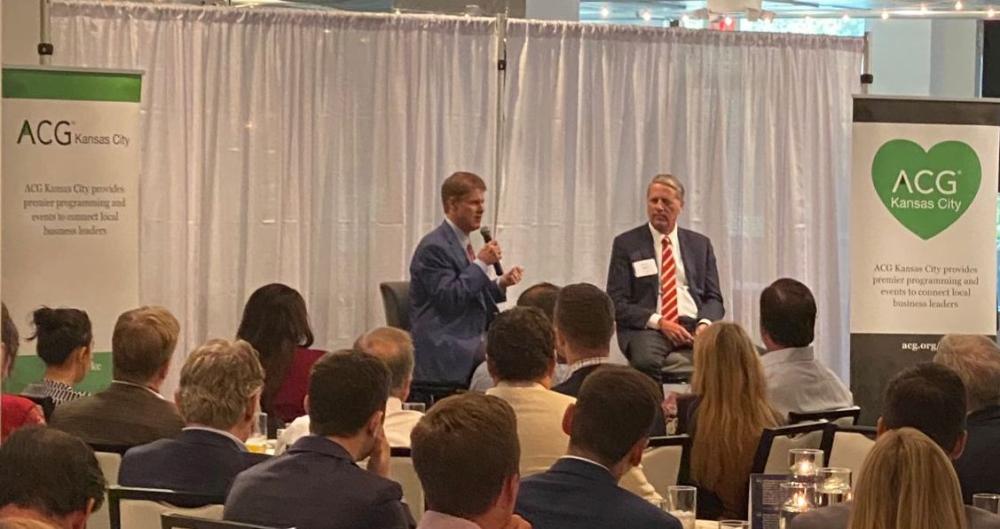
Clark Hunt, Chairman & CEO, Kansas City Chiefs

The late Lamar Hunt knew something about building a championship culture — in his vision for his career, in the boardroom and the front office, and on the field of play.
Hunt’s son Clark Hunt, chairman and CEO of the Kansas City Chiefs, told the story of his father’s creation of the American Football League, the Dallas Texans and its progeny the Chiefs, and of the Chiefs’ importance to Kansas City for five decades, at ACG’s monthly meeting on Aug. 26. About 200 people attended.
Clark Hunt said his father’s nickname in his youth was “Games” because he invented games for his brothers, sisters and friends to play. Lamar Hunt later played football at Southern Methodist University and also developed a love for soccer.
He was 26 when he started working in his family’s oil and gas business in 1958, “and he quickly learned that he hated the oil and gas business and started charting a path to get into the professional sports business,” Clark Hunt said.
Lamar Hunt visited the National Football League’s commissioner and said he wanted to buy an expansion team for Dallas. The commissioner said the NFL didn’t want to expand and called Dallas “a horrible market for professional football.” The future in Dallas would tell a different story, with the Cowboys called “America’s team” in the late 1970s.
The commissioner advised Hunt to contact the then-Chicago Cardinals’ owner, who might want to sell him an interest in his team. Hunt met several times with the owner, who told him others had approached him wanting to buy his team. Hunt was flying on American Airlines back to Dallas from Miami after his final visit with the Cardinals’ owner, “and it was like a lightbulb went off in his head,” Clark Hunt said.
“My dad said, ‘If there are others interested in owning teams for their cities, maybe I’ll go see those people and start my own league.’”
That he did, in 1960, with eight teams including his Dallas Texans. The NFL’s Dallas Cowboys started that same year.
He moved the Texans to Kansas City in 1963 and through a contest renamed the team the Chiefs. In January 1967, the Green Bay Packers beat the fledgling Chiefs in the first Super Bowl — whose name he reportedly had coined. The Chiefs claimed their first victory in the big game in Super Bowl IV in January 1970, beating the Minnesota Vikings 23-7. The AFL and NFL officially merged later that year.
Clark Hunt also spoke of legendary Chiefs quarterback and sports broadcaster Len Dawson, who died on Aug. 24 at age 87.
“This week has been a hard week,” he said. “We all lost somebody who was such a huge part of our lives, whether it was as a championship quarterback for the Chiefs or a broadcaster here in Kansas City and really the face of the NFL when he was one of the hosts of [HBO’s “Inside the NFL”]. Len Dawson had an amazing, amazing two careers and did so much for the city of Kansas City.”
Clark Hunt has followed in those footsteps of Dawson and of his father. He was named as Chiefs CEO in 2010. In January 2013, he restructured the Chiefs organization so that the head coach, general manager and president would all report directly him to unify the team’s operation, according to his biography.
He hired Andy Reid as head coach in 2013. In nine seasons under Reid, the Chiefs won 103 regular season games, tied for the most in the NFL during that period, and made the playoffs eight times (2013 and 2015 through 2021), claiming six straight AFC West titles (2016 through 2021).
Clark Hunt indeed has built for the Chiefs a championship culture through collaborative leadership, accountability for all and a personal touch. He prized finding a common vision and common values throughout the Chiefs organization.
He described an exemplification of that philosophy by comparing Dawson with the Chiefs’ already legendary young quarterback Patrick Mahomes. They both “put their teammates ahead of themselves.”
He described what the Chiefs have meant to Kansas City over the years. He reminisced about watching the Downtown parade after the team’s victory in Super Bowl IV. He was nearly 5 years old then. He called the parade “one of the most memorable things in my entire life.”
“Being part of it and having really the entire city come out (the crowd was estimated at 1 million people), it was as if the collective joy of the entire city was being projected on us.”

Register by January 14 to lock in the lowest rate and join 3,200+ dealmakers in Las Vegas on April 27-29, 2026.
